Dependence of Pressure Characteristics of Pressurized Pulse Water Jet Chamber on Nozzle Diameter
Abstract
:1. Introduction
2. Pressure Boosting Theory of a Pressurized Pulse Water Jet Generator
2.1. Equations of Motion of the Generator
2.2. Critical Nozzle Model
3. Experimentation
3.1. Experimental System
3.2. Selection Basis for the Main Control Parameters
3.3. Experimental Scheme
- ➀
- Install and fix a pressurized pulse water jet generator, and install pressure sensors at the oil inlet, return port, and boost chamber, respectively;
- ➁
- Start the water pump, adjust the pressure of the water pump to the set inlet pressure, and maintain stability;
- ➂
- Start the oil pump and adjust the pressure of the oil pump to the set inlet pressure. At this point, the pressurized pulse water jet generator begins to operate, and the plunger periodically compresses the fluid in the pressurized chamber, causing periodic changes in the fluid pressure in the pressurized chamber;
- ➃
- Conduct experiments in the order shown in Table 1 and collect the pressure data on the booster chamber for the different nozzle diameters.
3.4. Error Analysis
4. Results and Discussion
4.1. Characteristics of Pressure Pulsation in the Booster Chamber
4.2. The Influence of the Nozzle Diameter on the Pressure Amplitude
- ➀
- Peak pressure. As the diameter of the nozzle outlet increases, the peak pressure in the boost chamber gradually decreases. When the movement speed of the piston is fixed, the diameter of the nozzle affects the peak pressure of the boost chamber. As the diameter of the nozzle increases, the peak pressure of the boost chamber gradually decreases. As the diameter of the nozzle increases, the overflow effect of the nozzle cannot be ignored. As the diameter of the nozzle increases, the compression per unit volume continuously decreases, and thus the pressure level gradually decreases.
- ➁
- Steady oscillation section pressure. As the diameter of the nozzle outlet increases, the steady oscillation pressure gradually decreases, and under the current operating conditions, when the nozzle diameter is 0.8 mm or 1.0 mm, the steady oscillation section disappears, that is, there is no steady oscillation pressure. As the diameter of the nozzle increases, the compression per unit volume decreases, and the pressure during the steady oscillation stage decreases accordingly.
- ➂
- Trough pressure. As the diameter of the nozzle outlet increases, there is no significant change in the trough pressure of the pressurized chamber fluid. The trough pressure of the boost chamber depends on the inlet pressure during the return stage, which is the initial pressure of the boost chamber and is independent of the nozzle diameter.
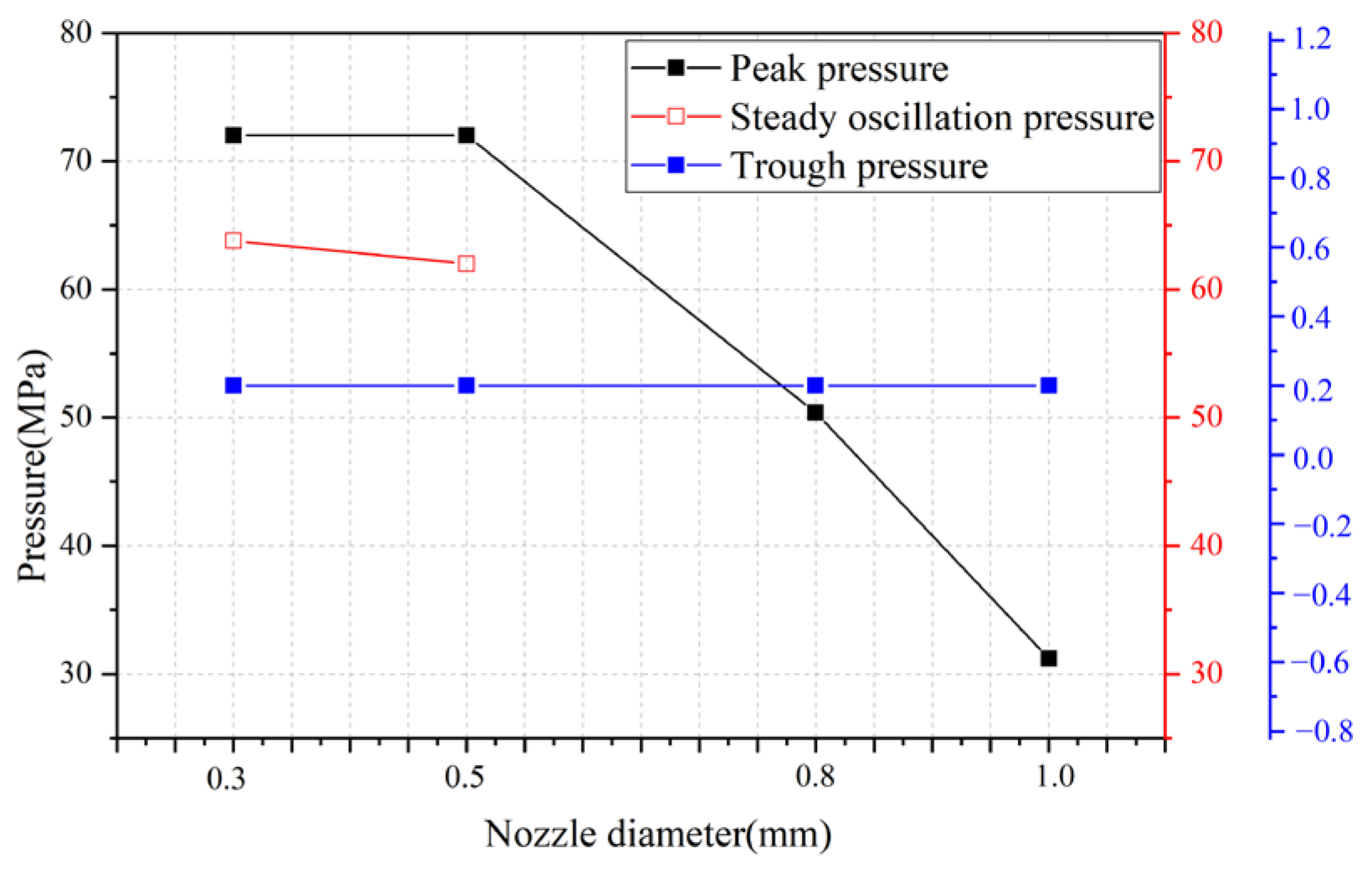
4.3. The Influence of the Nozzle Diameter on the Pressure Cycle
- ➀
- Climb time. As shown in Figure 10a, as the nozzle outlet diameter increases, there is no significant change in the time it takes for the fluid pressure in the booster chamber to climb to the peak pressure. As mentioned above, the climbing time depends on the propagation speed of the water hammer wave, so there is no significant change in the climbing time of the peak pressure.
- ➁
- The duration of the steady oscillation phase. As shown in Figure 10b, as the diameter of the nozzle outlet increases, the duration of the steady oscillation section continuously decreases. When the nozzle diameter increases to 0.8 mm and 1.0 mm, the duration of the steady oscillation section decreases to 0 s, meaning that the steady oscillation section disappears. As the nozzle diameter further increases, the overflow effect of the nozzle on the pressurization process cannot be ignored. The movement speed of the squeezing plunger further increases, and the stroke time decreases. On the premise of maintaining the climbing time, the duration of the steady oscillation stage gradually decreases.
- ➂
- Fall time. As shown in Figure 10c, as the diameter of the nozzle outlet increases, there is no significant change in the time required for the descending section.
- ➃
- Stroke time. As shown in Figure 10d, with the increase in the nozzle outlet diameter, the time consumed in the stroke stage of the extrusion plunger decreases and tends to be flat.
- ➄
- Return time. As shown in Figure 10e, with the increase in the nozzle outlet diameter, the return time of the extrusion plunger has no significant change. In the return stage, the movement of the squeezing piston is mainly completed by the combined action of the driving pressure and the initial pressure of the boosting chamber, independent of the nozzle diameter.
- ➅
- Duration and frequency of a single cycle. In Figure 11, it can be seen that as the diameter of the nozzle outlet increases, the duration of a single cycle in the supercharging chamber continuously decreases, and the impact frequency continuously increases, and tends to be gentle. The corresponding relationship between the nozzle diameter and the duration of a single cycle under the current operating conditions can be obtained using polynomial fitting, as shown in Equation (19):
4.4. The Influence of the Nozzle Diameter on the Boost Ratio
5. Conclusions
- (1)
- A critical nozzle diameter equation for a pressurized pulse water jet generator has been established. There exists a critical nozzle diameter, and the specific size of the diameter depends on the theoretical boost ratio, the inlet oil flow rate, and the inlet oil pressure. The inlet oil flow rate is directly proportional to the critical nozzle diameter, the theoretical boost ratio is inversely proportional to the critical nozzle diameter, and the inlet oil pressure is inversely proportional to the critical nozzle diameter.
- (2)
- The critical nozzle diameter of this set of pressurized pulsed water jet generators is 0.6 mm. When the nozzle diameter is greater than the critical diameter, as the nozzle diameter increases, the pressure in the booster chamber tends to change towards a “short and narrow” trend. As the nozzle diameter increases, the peak pressure of the boost chamber decreases, the duration of a single cycle continuously decreases, and the frequency increases.
- (3)
- When the nozzle diameter is less than the critical diameter, as the nozzle diameter increases, the peak pressure in the booster chamber tends to decrease, but the reduction amplitude is weak. The duration of a single cycle gradually decreases and the frequency increases. The nozzle is not involved in the device pressurization process but provides a load for the establishment of the pressurization chamber pressure, which is dependent on the nozzle diameter. Therefore, in order to obtain a higher output pressure, we should choose a nozzle with a diameter that is smaller than the critical diameter. At the same time, a large nozzle diameter can output more energy. We should finally choose a nozzle diameter that is similar to the critical diameter, such as 0.6 mm, 0.5 mm, or 0.55 mm.
Author Contributions
Funding
Data Availability Statement
Acknowledgments
Conflicts of Interest
References
- Lu, J.; Gong, Q.; Yin, L.; Thuro, K.; Su, G. True-triaxial experimental study on the brittle failure of granite conditioned by the TBM disc cutter. Int. J. Rock Mech. Min. Sci. 2023, 170, 105477. [Google Scholar] [CrossRef]
- Afrasiabi, N.; Rafiee, R.; Noroozi, M. Investigating the effect of discontinuity geometrical parameters on the TBM performance in hard rock. Tunn. Undergr. Space Technol. 2019, 84, 326–333. [Google Scholar] [CrossRef]
- Wu, Z.; Lei, L.; Su, Y.; Yang, K.; Zheng, J.; Zhou, Z. Limpet radula-inspired triangular groove TBM cutter for hard rock breakage with low specific wear. Tribol. Int. 2023, 187, 108721. [Google Scholar] [CrossRef]
- Xia, Y.; Yin, X.; Fu, J.; Liu, Y.; Cui, J.; Zhang, H. Study on the distribution and variation of temperature field in the rock breaking process of TBM disc cutter. Int. J. Therm. Sci. 2023, 186, 108086. [Google Scholar] [CrossRef]
- Zheng, Y.-L.; He, L. TBM tunneling in extremely hard and abrasive rocks: Problems, solutions and assisting methods. J. Cent. South Univ. 2021, 28, 454–480. [Google Scholar] [CrossRef]
- Farrokh, E. Cutter change time and cutter consumption for rock TBMs. Tunn. Undergr. Space Technol. 2021, 114, 104000. [Google Scholar] [CrossRef]
- Li, B.; Zhang, B.; Hu, M.; Liu, B.; Cao, W.; Xu, B. Full-scale linear cutting tests to study the influence of pre-groove depth on rock-cutting performance by TBM disc cutter. Tunn. Undergr. Space Technol. 2022, 122, 104366. [Google Scholar] [CrossRef]
- Wang, H.; Xia, B.; Lu, Y.; Ge, Z.; Tang, J. Experimental study on sonic vibrating effects of cavitation water jets and its promotion effects on coalbed methane desorption. Fuel 2016, 185, 468–477. [Google Scholar] [CrossRef]
- Wang, T.; Yan, C.; Zheng, H.; Ke, W.; Ali, S. Optimum spacing and rock breaking efficiency of TBM double disc cutters penetrating in water-soaked mudstone with FDEM. Tunn. Undergr. Space Technol. 2023, 138, 105174. [Google Scholar] [CrossRef]
- Liu, J.; Ling, J.; Cai, Y.; Ju, A.; Long, W.; Zhang, X. Study on damage mechanism of concrete under water jet combined with mechanical breaking. Arch. Civ. Mech. Eng. 2023, 23, 139. [Google Scholar] [CrossRef]
- Liu, J.; Zhu, B.; Liu, R.; Ling, J.; Long, W.; Zhang, X. Study on parameter analysis and damage mechanism of water jet combined with mechanical cutter head breaking concrete. J. Build. Eng. 2022, 61, 105314. [Google Scholar] [CrossRef]
- Zhu, D.; Yu, B.; Wang, D.; Zhang, Y. Fusion of finite element and machine learning methods to predict rock shear strength parameters. J. Geophys. Eng. 2024, 21, gxae064. [Google Scholar] [CrossRef]
- Stoxreiter, T.; Martin, A.; Teza, D.; Galler, R. Hard rock cutting with high pressure jets in various ambient pressure regimes. Int. J. Rock Mech. Min. Sci. 2018, 108, 179–188. [Google Scholar] [CrossRef]
- Tripathi, R.; Hloch, S.; Chattopadhyaya, S.; Adamcik, P.; Das, A.K. An Acoustic Emission Study of Rock Disintegration by Pulsating Water-Jet. In Advances in Manufacturing Engineering and Materials; Springer: Cham, Switzerland, 2019; pp. 156–162. [Google Scholar]
- Lu, Y.; Zhang, Y.; Tang, J.; Yao, Q. Switching mechanism and optimisation research on a pressure-attitude adaptive adjusting coal seam water jet slotter. Int. J. Min. Sci. Technol. 2022, 32, 1167–1179. [Google Scholar] [CrossRef]
- Cao, S.; Ge, Z.; Zhou, Z.; Gao, F.; Liu, W.; Lu, Y. Fracturing mechanism and pore size distributions of rock subjected to water jets under in-situ stress: Breakage characteristics investigation. J. Pet. Sci. Eng. 2022, 213, 110392. [Google Scholar] [CrossRef]
- Cheng, J.-L.; Yang, S.-Q.; Han, W.-F.; Zhang, Z.-R.; Jiang, Z.-H.; Lu, J.-F. Experimental and numerical study on the indentation behavior of TBM disc cutter on hard-rock precutting kerfs by high-pressure abrasive water jet. Arch. Civ. Mech. Eng. 2022, 22, 37. [Google Scholar] [CrossRef]
- Jiang, Y.; Zeng, J.; Xu, C.; Xiong, F.; Pan, Y.; Chen, X.; Lei, Z. Experimental study on TBM cutter penetration damage process of highly abrasive hard rock pre-cut by high-pressure water jet. Bull. Eng. Geol. Environ. 2022, 81, 511. [Google Scholar] [CrossRef]
- Luo, X.; Zhang, J.; Yang, F.; He, F.; Xia, Y. Research on the hard rock cutting characteristics of disc cutter under front-mounted water jet precutting kerf conditions. Eng. Fract. Mech. 2023, 287, 109330. [Google Scholar] [CrossRef]
- Zhang, X.; Hu, D.; Li, J.; Pan, J.; Xia, Y.; Tian, Y. Investigation of rock breaking mechanism with TBM hob under traditional and free-face condition. Eng. Fract. Mech. 2021, 242, 107432. [Google Scholar] [CrossRef]
- Zhang, J.-L.; Yang, F.-W.; Cao, Z.-G.; Xia, Y.-M.; Li, Y.-C. In situ experimental study on TBM excavation with high-pressure water-jet-assisted rock breaking. J. Cent. South Univ. 2023, 29, 4066–4077. [Google Scholar] [CrossRef]
- Ge, Z.; Ling, Y.; Tang, J.; Lu, Y.; Zhang, Y.; Wang, L.; Yao, Q. Formation Principle and Characteristics of Self-Supercharging Pulsed Water Jet. Chin. J. Mech. Eng. 2022, 35, 51. [Google Scholar] [CrossRef]
- Ling, Y.; Ge, Z.; Tang, J.; Lu, Y.; Zhang, Y.; Wang, L. Development of a hydraulically controlled piston-pressurized pulsed water jet device and its application potential for hard rock breaking. Rev. Sci. Instrum. 2021, 92, 085101. [Google Scholar] [CrossRef] [PubMed]
- Zhang, Y.; Li, Q. Influence of Hydraulic Parameters on Multi-Stage Pulse Characteristics of Pressurized Pulsed Water Jet. Processes 2023, 11, 2502. [Google Scholar] [CrossRef]
- Zhang, Y.; Lu, Y.; Tang, J.; Ling, Y.; Wang, L.; Yao, Q.; Zhu, Z. Development and application of rock breaking platform with variable cross section extrusion pulsed water jet. J. Mech. Sci. Technol. 2022, 36, 2837–2848. [Google Scholar] [CrossRef]
- Zhang, Y.; Long, H.; Tang, J.; Ling, Y. Experimental Investigation on the Granite Erosion Characteristics of a Variable Cross-Section Squeezed Pulsed Water Jet. Appl. Sci. 2023, 13, 5393. [Google Scholar] [CrossRef]
- Wen, J.; Qi, Z.; Behbahani, S.S.; Pei, X.; Iseley, T. Research on the structures and hydraulic performances of the typical direct jet nozzles for water jet technology. J. Braz. Soc. Mech. Sci. Eng. 2019, 41, 570. [Google Scholar] [CrossRef]
- Apte, D.; Ge, M.; Coutier-Delgosha, O. Numerical investigation of a cavitating nozzle for jetting and rock erosion based on different turbulence models. Geoenergy Sci. Eng. 2023, 231, 212300. [Google Scholar] [CrossRef]
- Chong, D.; Zhao, Q.; Yuan, F.; Wang, W.; Chen, W.; Yan, J. Research on the steam jet length with different nozzle structures. Exp. Therm. Fluid Sci. 2015, 64, 134–141. [Google Scholar] [CrossRef]
- Huang, L.-Y.; Chen, Z.S. Effect of technological parameters on hydrodynamic performance of ultra-high-pressure water-jet nozzle. Appl. Ocean Res. 2022, 129, 103410. [Google Scholar] [CrossRef]
- Juraeva, M.; Song, D.J.; Kang, D.J. Computational optimization approach to design a water-jet nozzle for a water-jet loom using the design of experiment method. J. Mech. Sci. Technol. 2019, 33, 631–637. [Google Scholar] [CrossRef]
- Kumar, C.P.; Lee, K.H.; Park, T.C.; Cha, B.J.; Kim, H.D. Optimization study on pin tip diameter of an impact-pin nozzle at high pressure ratio. J. Mech. Sci. Technol. 2016, 30, 4001–4006. [Google Scholar] [CrossRef]
- Li, D.; Kang, Y.; Ding, X.; Wang, X.; Fang, Z. Effects of area discontinuity at nozzle inlet on the characteristics of high speed self-excited oscillation pulsed waterjets. Exp. Therm. Fluid Sci. 2016, 79, 254–265. [Google Scholar] [CrossRef]
- Li, D.; Kang, Y.; Ding, X.; Wang, X.; Liu, W. Effects of feeding pipe diameter on the performance of a jet-driven Helmholtz oscillator generating pulsed waterjets. J. Mech. Sci. Technol. 2017, 31, 1203–1212. [Google Scholar] [CrossRef]
- Liu, C.; Liu, G.; Yan, Z. Study on Cleaning Effect of Different Water Flows on the Pulsed Cavitating Jet Nozzle. Shock Vib. 2019, 2019, 1496594. [Google Scholar] [CrossRef]
- Marcon, A.; Melkote, S.N.; Yoda, M. Effect of nozzle size scaling in co-flow water cavitation jet peening. J. Manuf. Process. 2018, 31, 372–381. [Google Scholar] [CrossRef]
- Raj, P.; Hloch, S.; Tripathi, R.; Srivastava, M.; Nag, A.; Klichová, D.; Klich, J.; Hromasová, M.; Muller, M.; Miloslav, L.; et al. Investigation of sandstone erosion by continuous and pulsed water jets. J. Manuf. Process. 2019, 42, 121–130. [Google Scholar] [CrossRef]
- Říha, Z.; Zeleňák, M.; Kruml, T.; Poloprudský, J. Comparison of the disintegration abilities of modulated and continuous water jets. Wear 2021, 478–479, 203891. [Google Scholar] [CrossRef]
- Song, X.; Lv, Z.; Li, G.; Hu, X.; Shi, Y. Numerical analysis of characteristics of multi-orifice nozzle hydrothermal jet impact flow field and heat transfer. J. Nat. Gas Sci. Eng. 2016, 35, 79–88. [Google Scholar] [CrossRef]
- Sripanagul, G.; Matthujak, A.; Sriveerakul, T.; Phongthanapanich, S. Experimental investigation of stone drilling using water jet generated by electromagnetic actuator. Int. J. Rock Mech. Min. Sci. 2021, 142, 104697. [Google Scholar] [CrossRef]
- Srivastava, M.; Nag, A.; Chattopadhyaya, S.; Hloch, S. Standoff Distance in Ultrasonic Pulsating Water Jet. Materials 2020, 14, 88. [Google Scholar] [CrossRef]
- Tripathi, R.; Hloch, S.; Chattopadhyaya, S.; Klichová, D.; Ščučka, J.; Das, A.K. Application of the pulsating and continous water jet for granite erosion. Int. J. Rock Mech. Min. Sci. 2020, 126, 104209. [Google Scholar] [CrossRef]
- Wang, Z.A.; Kang, Y.; Wang, X.; Li, D.; Shi, H. Effects of modulation position on the impact performance of mechanically modulated pulsed water jet. J. Manuf. Process. 2020, 56, 510–521. [Google Scholar] [CrossRef]
- Xu, Y.; Liu, H.; Wang, Z.; Zhang, J.; Wang, J. Analysis of the Effects of Nozzle Geometry on the Cavitation Water Jet Flow Field Using Orthogonal Decomposition, Iranian Journal of Science and Technology. Trans. Mech. Eng. 2024, 48, 119–132. [Google Scholar]
- Zeleňák, M.; Říha, Z.; Jandačka, P. Visualization and velocity analysis of a high-speed modulated water jet generated by a hydrodynamic nozzle. Measurement 2020, 159, 107753. [Google Scholar] [CrossRef]
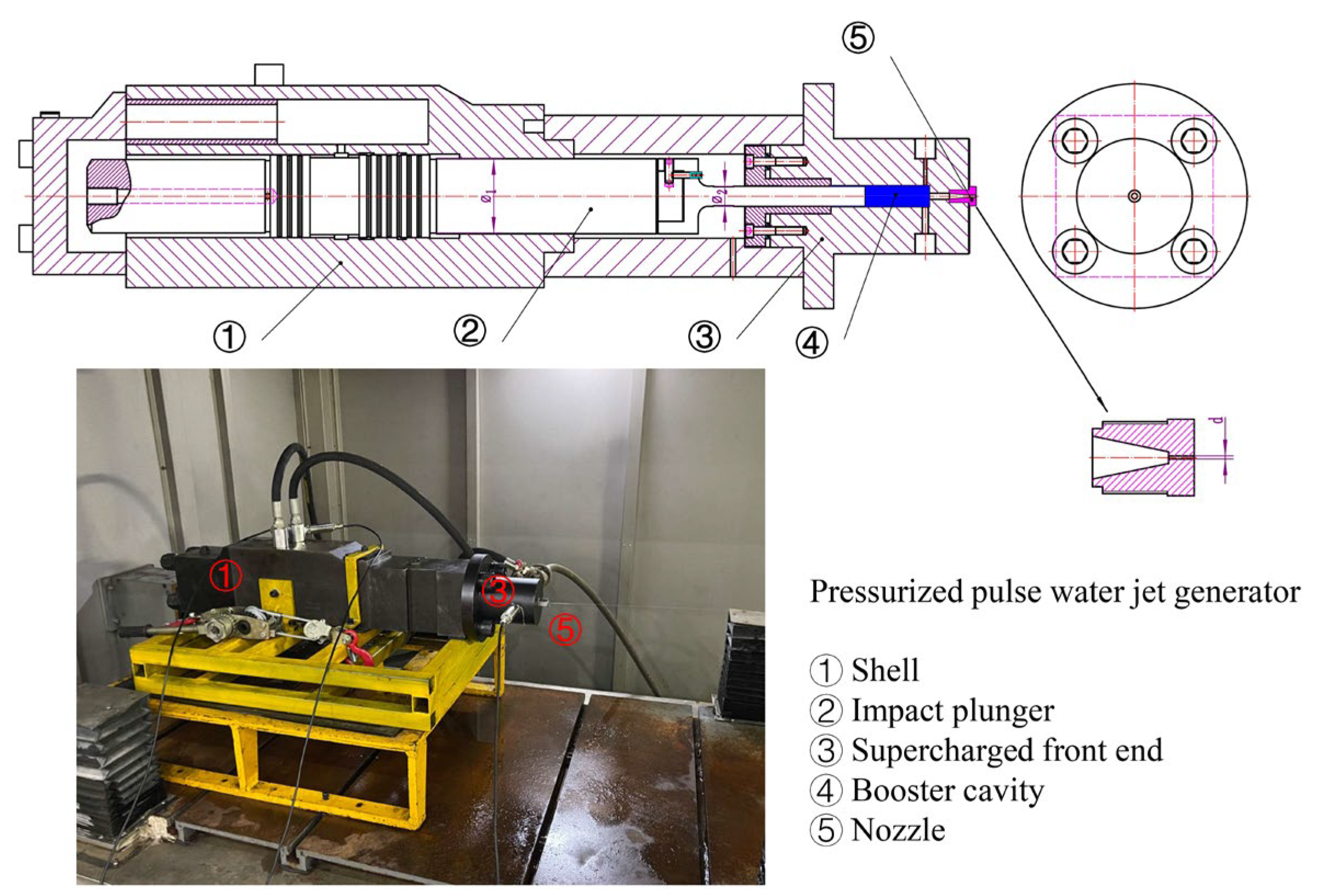


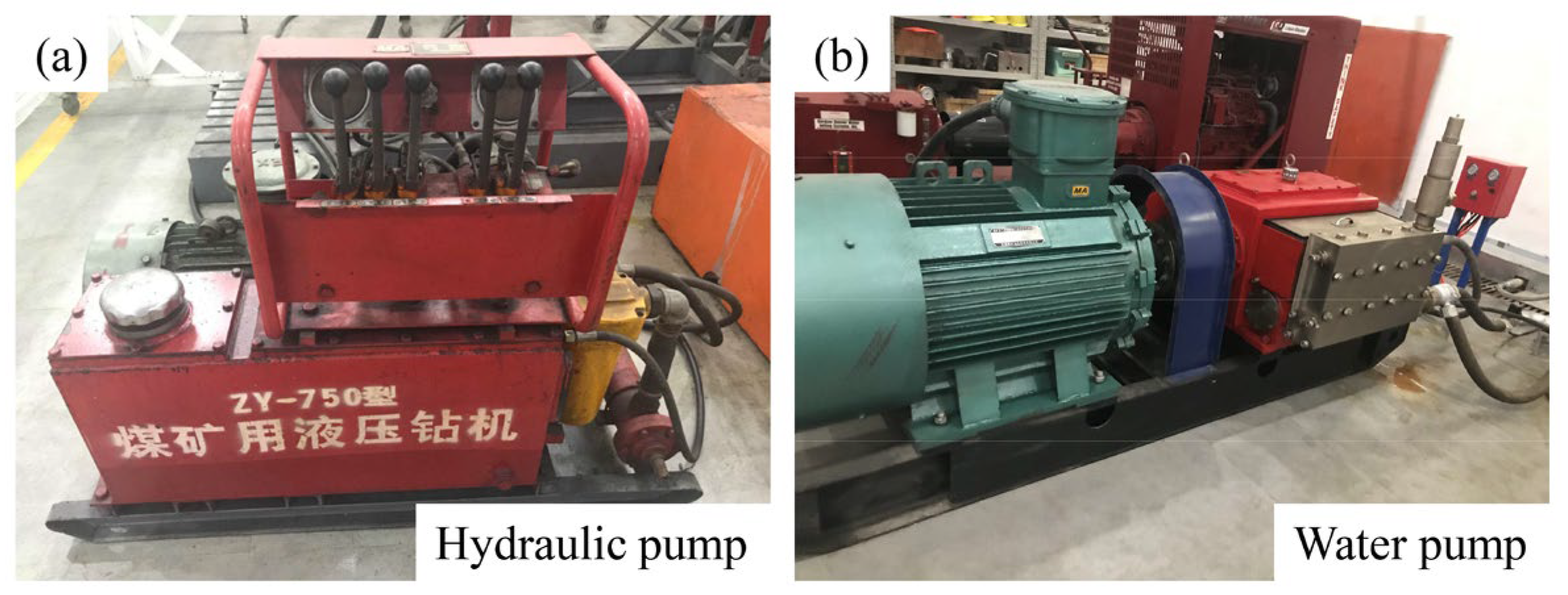
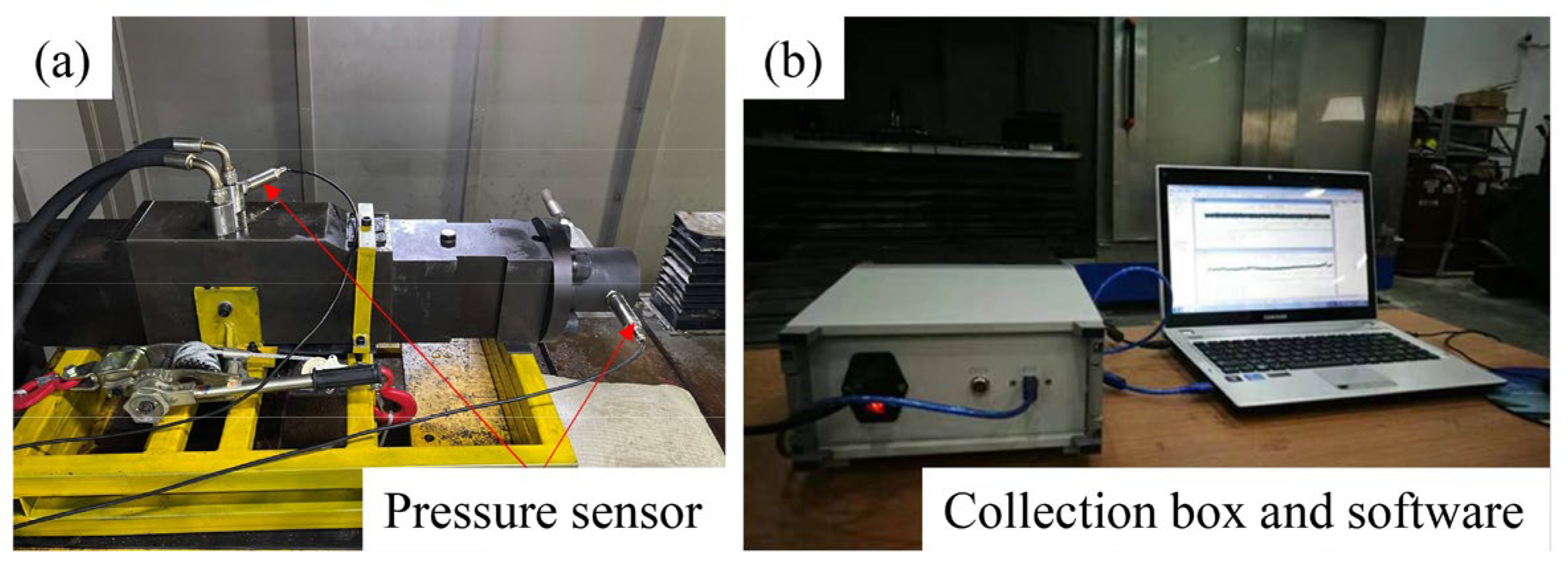
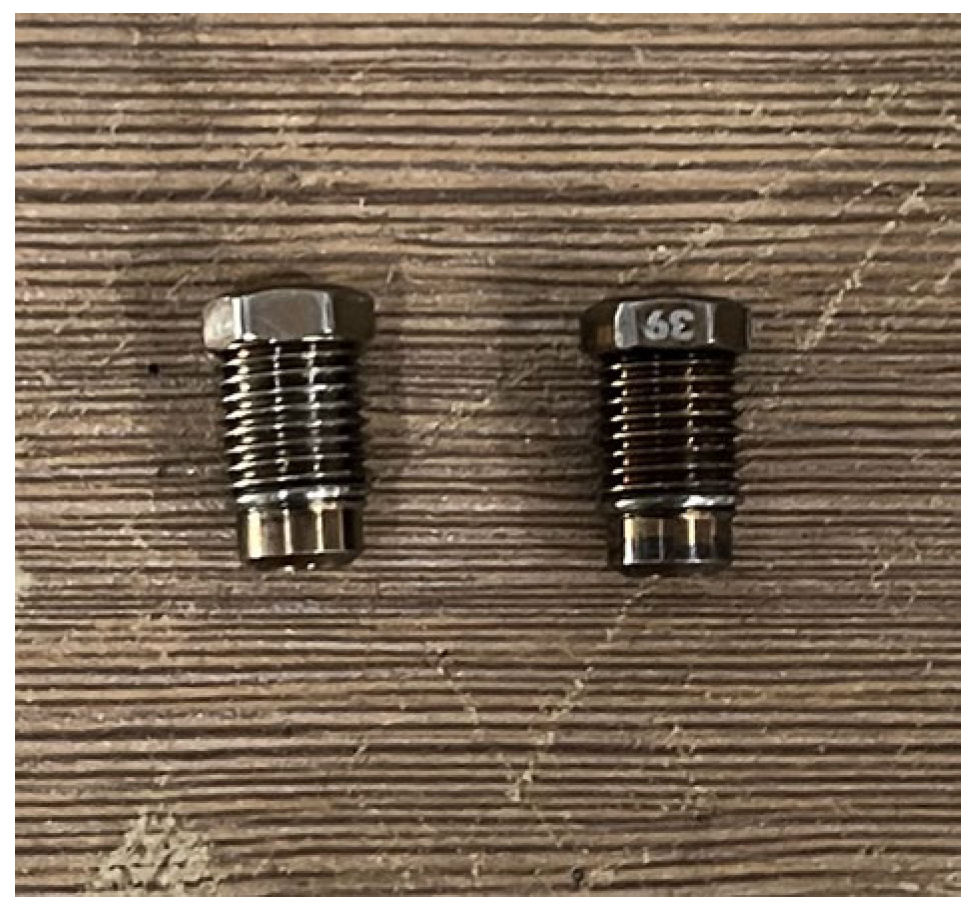
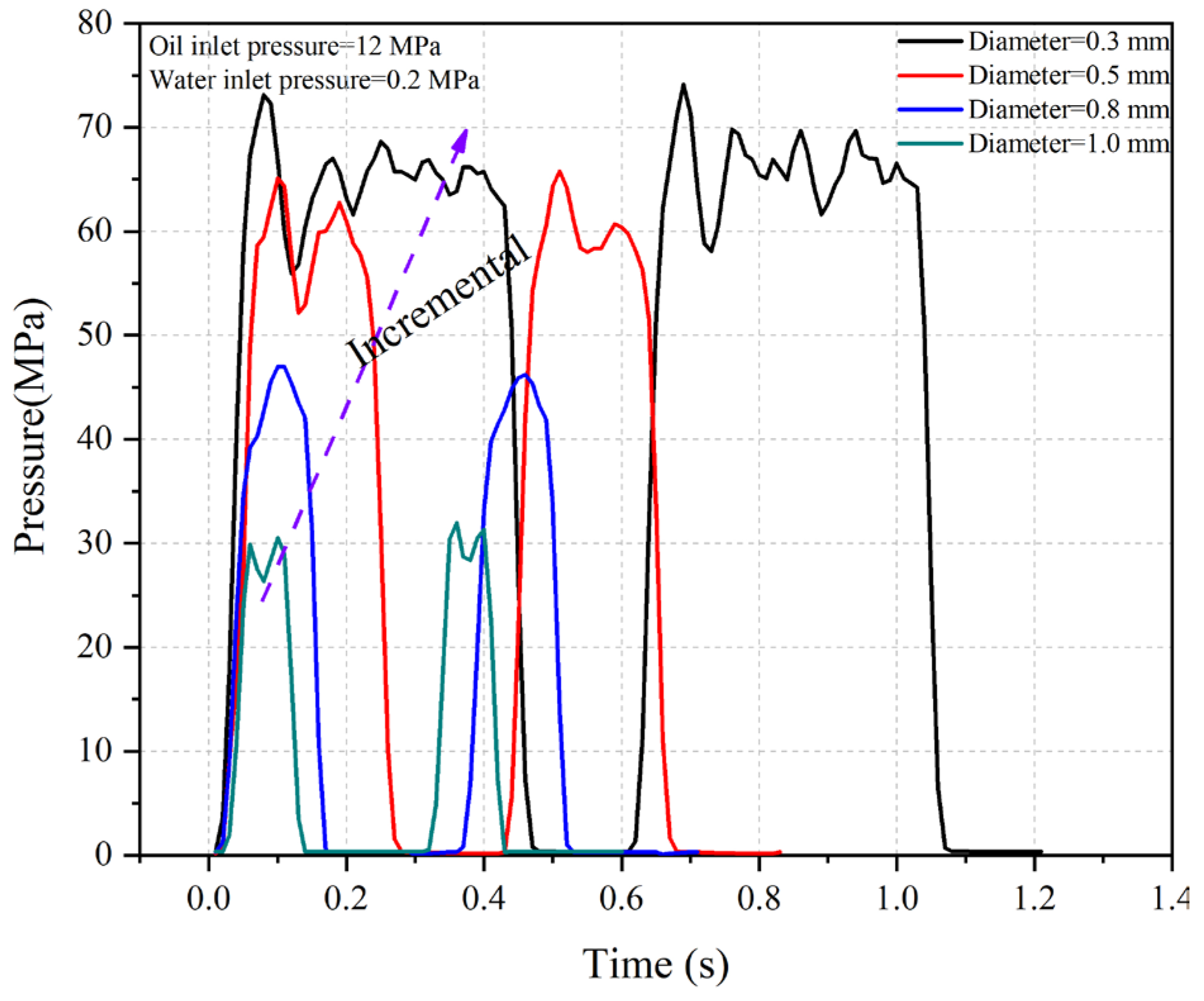
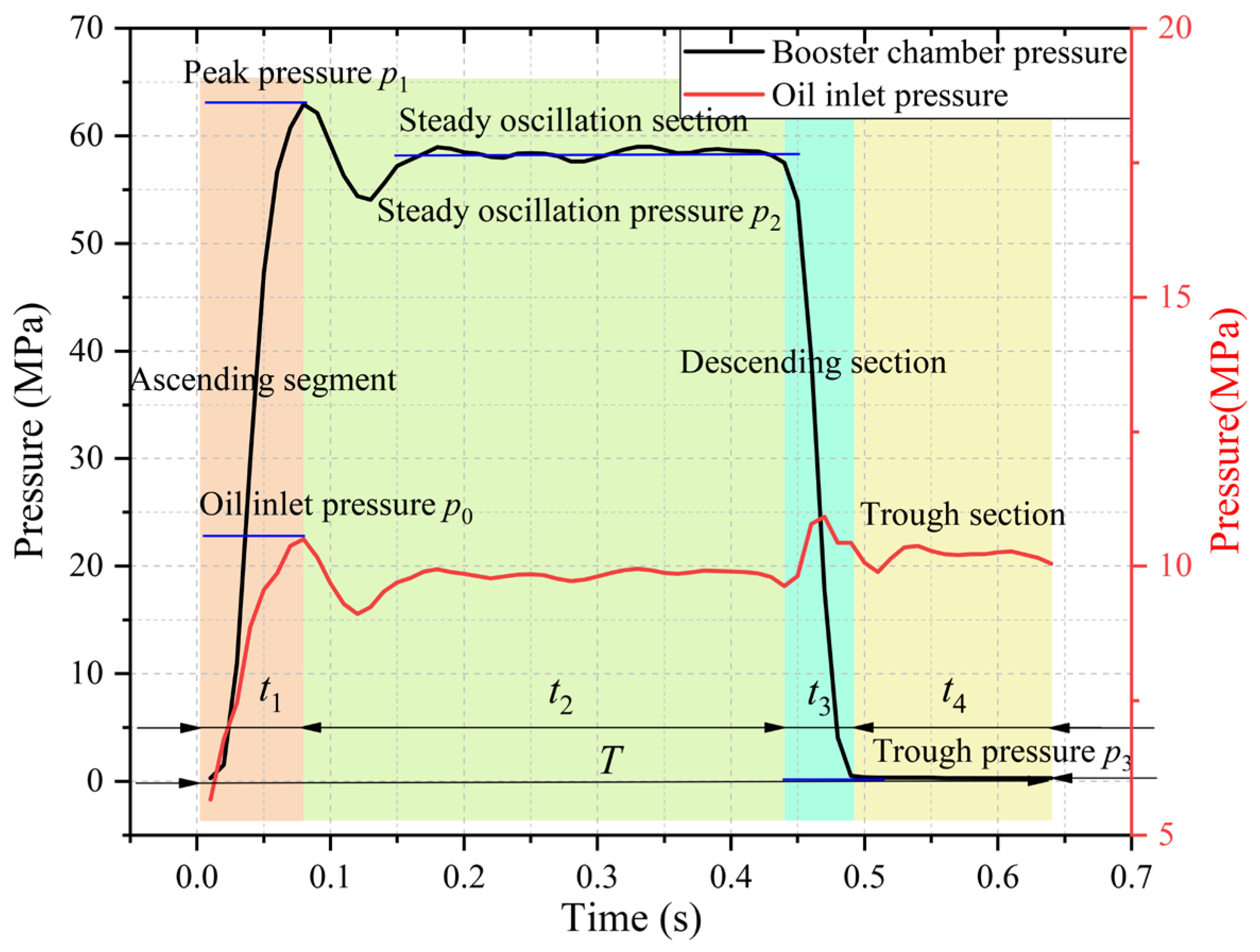
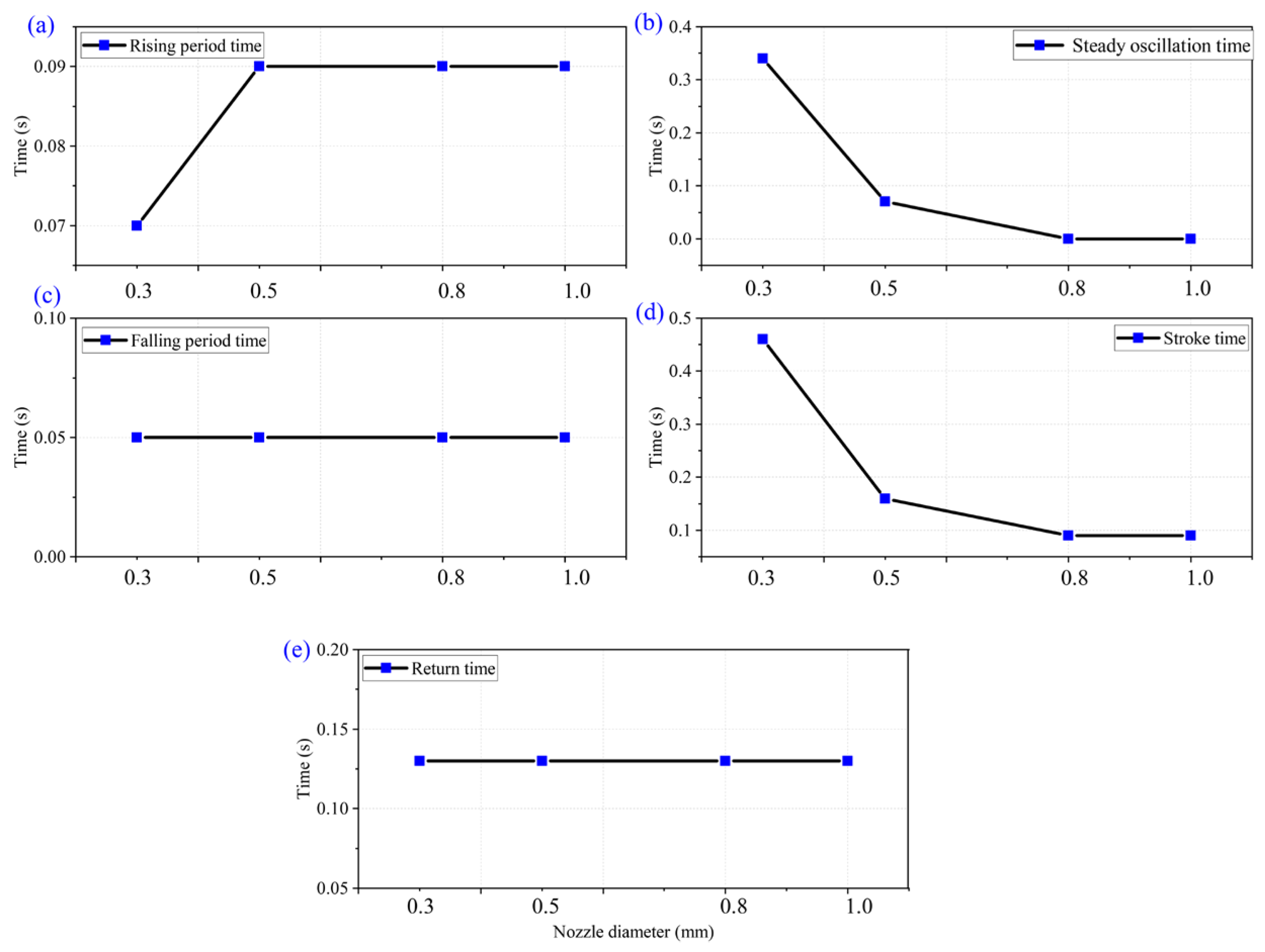
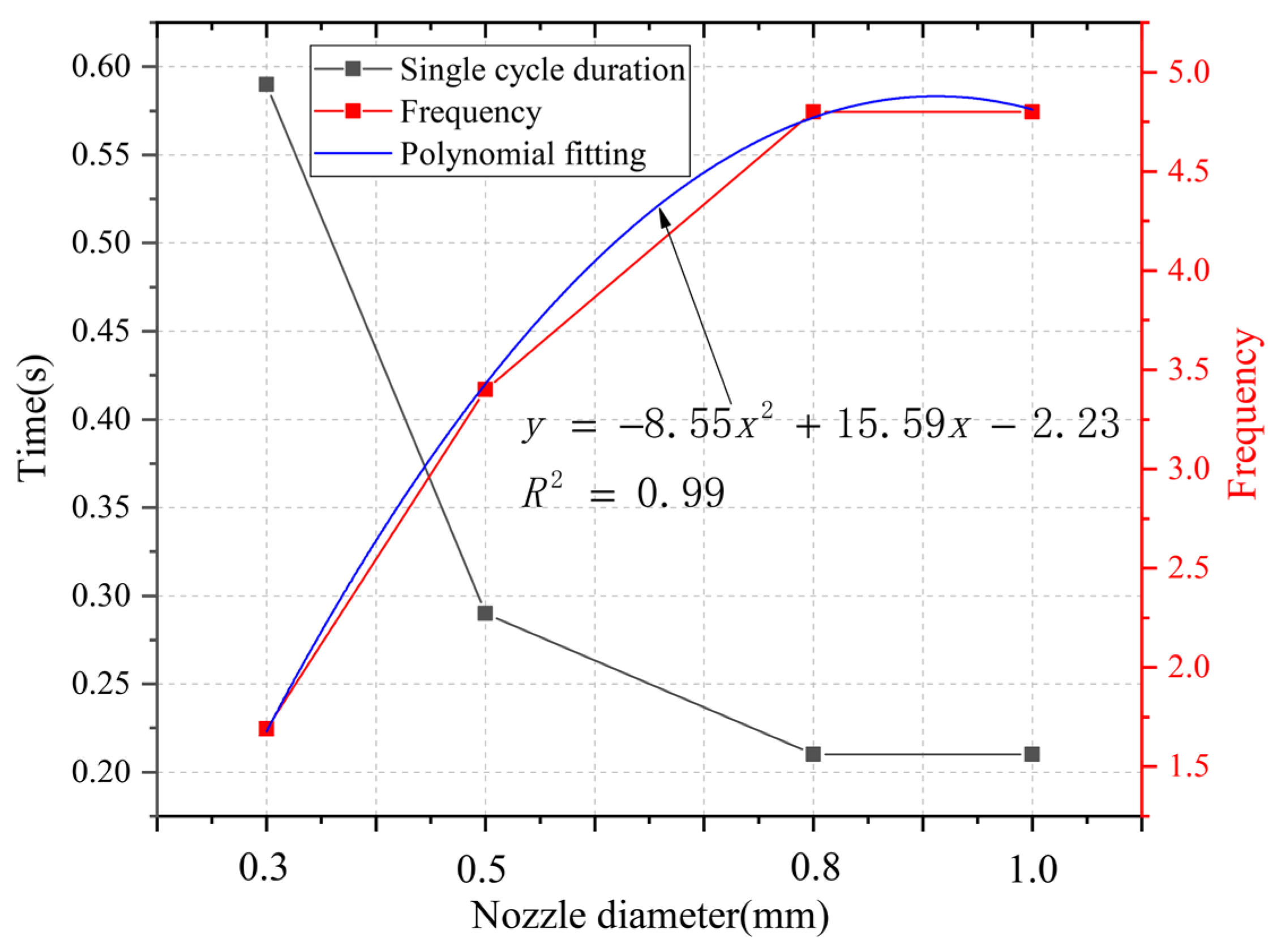

| Oil Inlet Pressure (MPa) | Water Inlet Pressure (MPa) | Nozzle Diameter (mm) |
|---|---|---|
| 12 | 0.2 | 0.3, 0.5, 0.8, 1.0 |
Disclaimer/Publisher’s Note: The statements, opinions and data contained in all publications are solely those of the individual author(s) and contributor(s) and not of MDPI and/or the editor(s). MDPI and/or the editor(s) disclaim responsibility for any injury to people or property resulting from any ideas, methods, instructions or products referred to in the content. |
© 2024 by the authors. Licensee MDPI, Basel, Switzerland. This article is an open access article distributed under the terms and conditions of the Creative Commons Attribution (CC BY) license (https://creativecommons.org/licenses/by/4.0/).
Share and Cite
Miao, S.; Zhang, Y. Dependence of Pressure Characteristics of Pressurized Pulse Water Jet Chamber on Nozzle Diameter. Processes 2024, 12, 1708. https://doi.org/10.3390/pr12081708
Miao S, Zhang Y. Dependence of Pressure Characteristics of Pressurized Pulse Water Jet Chamber on Nozzle Diameter. Processes. 2024; 12(8):1708. https://doi.org/10.3390/pr12081708
Chicago/Turabian StyleMiao, Sizhong, and Yangkai Zhang. 2024. "Dependence of Pressure Characteristics of Pressurized Pulse Water Jet Chamber on Nozzle Diameter" Processes 12, no. 8: 1708. https://doi.org/10.3390/pr12081708
APA StyleMiao, S., & Zhang, Y. (2024). Dependence of Pressure Characteristics of Pressurized Pulse Water Jet Chamber on Nozzle Diameter. Processes, 12(8), 1708. https://doi.org/10.3390/pr12081708






